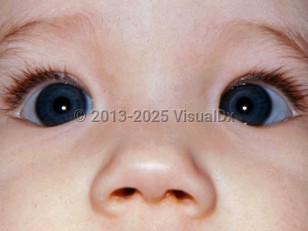Pseudoesotropia
Alerts and Notices
Important News & Links
Synopsis

The false illusion of esotropia, also known as pseudostrabismus. Abnormal periorbital anatomy results in the appearance of crossed eyes when in fact the ocular alignment is straight (orthoptic). May result from prominent epicanthal folds or flat nasal bridges that can obscure nasal sclera, producing the appearance of esotropia. Iris and pupil may disappear from view underneath the epicanthal folds when the affected patient looks to the side. Infants will typically outgrow the appearance of esotropia. However, it is still possible for a true esotropia to form.
Codes
ICD10CM:
H50.00 – Unspecified esotropia
SNOMEDCT:
95215008 – Pseudoesotropia
H50.00 – Unspecified esotropia
SNOMEDCT:
95215008 – Pseudoesotropia
Differential Diagnosis & Pitfalls

To perform a comparison, select diagnoses from the classic differential
Subscription Required
Best Tests
Subscription Required
References
Subscription Required
Last Updated:10/09/2022
Pseudoesotropia

